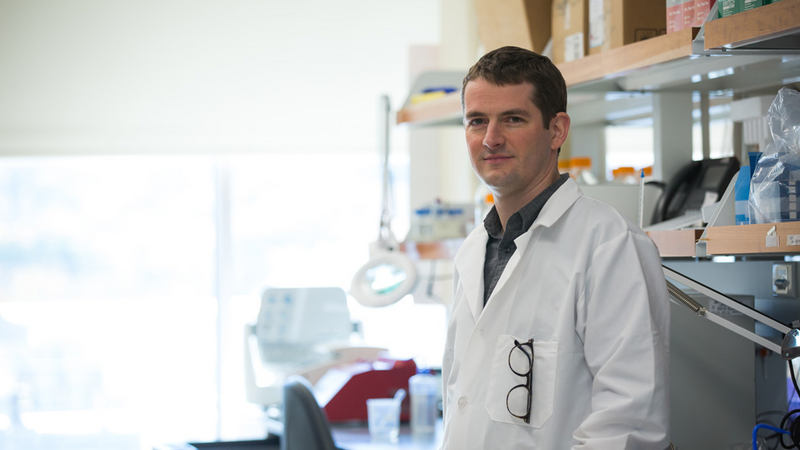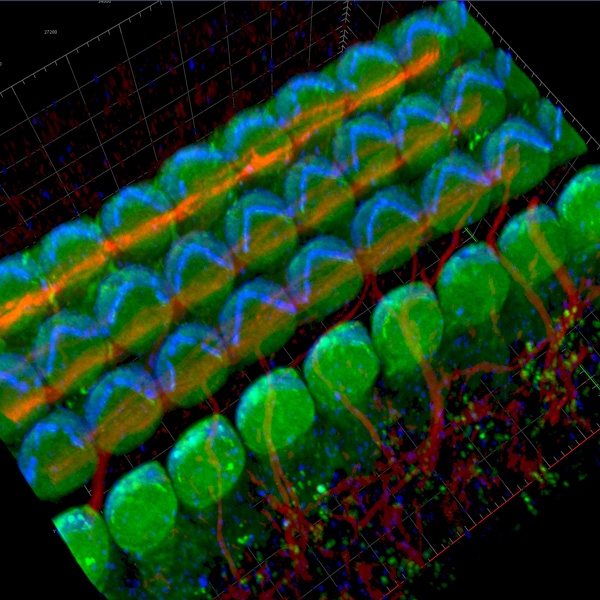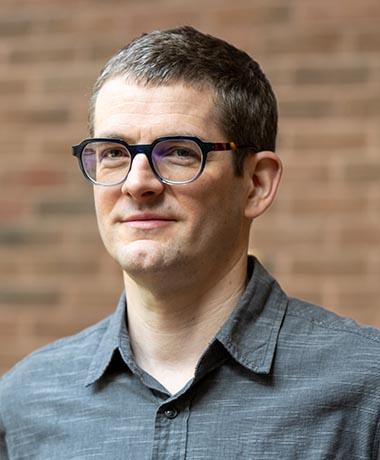Tuning in to the inner ear
The Search Magazine Article | May 21, 2018
Assistant Professor Basile Tarchini, Ph.D., is working to understand the basic mechanisms underlying hair cell development, with the goal of restoring hearing following injury.
Did you hear that sound? If so, you can thank your stereocilia.
These tiny fibers form bundles sitting atop sensory hair cells deep inside your inner ear, and give them their name. Stereocilia are as fragile and scarce as they are vital to your ability to hear.
Basile Tarchini studies stereocilia, which convert sound into hearing through complex signaling operations with the brain. The Jackson Laboratory (JAX) assistant professor’s work has revealed unexpected aspects of how stereocilia develop.
The inner ear is something we take for granted, the ability to perceive where our body is in space, to walk upright, to sense gravity.
Normal inner-ear stereocilia grow in a “staircase” formation, with a short-to-tall graduation of hairs in the bundle, arranged like kids in a class photo. “This staircase-like architecture of the hair bundle is essential for hearing and considered instrumental for direction-sensitivity to sound stimuli,” Tarchini says.
Here, in broad strokes, is how you hear. Sound waves enter the external ear and swirl down the ear canal until they reach the eardrum and set it vibrating. Tiny middle-ear bones connected to the eardrum amplify the sound waves and deliver them to the auditory portion of the inner ear, or cochlea.
Shaped like a snail shell and filled with fluid, the cochlea is divided into an upper and lower part by an elastic partition called the basilar membrane. In this liquid environment, the sound waves become fluid waves that travel along the basilar membrane. Inner-ear hair cells on the basilar membrane literally ride these waves.
The stereocilia at the top of the hair cells sway and bend in the flow. “There are tiny links between stereocilia,” Tarchini says, “linking the tallest to the next tallest and so on. Tension on those links cause pore-like channels at the tips of the stereocilia to open up, and ions rush into the cells, creating an electrical signal.
“This whole structure acts as a motion sensor.”
The auditory nerve carries the electrical signal to the brain, which recognizes and interprets the sound. Amazingly, the hair cells are arranged along the basilar membrane like the keys of a piano, high to low: Those near the entrance of the cochlea are responsible for detecting high-pitched sounds like birdsong and those close to the center of the “snail” sense lower-pitched sounds like far-off thunder.
In a healthy human cochlea, just about 16,000 hair cells handle this elaborate choreography of sound signaling, and only 4,000 of them are true sound receptors. By comparison, the retina of the human eye has about 127 million photoreceptors — rods and cones — to process visual signals.
Not only are hair cells rare, but they’re also vulnerable to environmental damage. Sustained loud noise from working in construction or the military, or attending a 1980s hair band tribute concert, can kill hair cells, and some antibiotics and cancer drugs also cause hair cell destruction.
Humans develop their hair cells very early in life — starting about 10 weeks post-conception. And humans, like mice and other mammals, are born with all the hair cells they will ever get, so once they’re lost they’re gone for good. On the other hand, birds, fish, and other non-mammals have the capacity to recover lost hearing through various regenerative processes.

Working with mice, Tarchini discovered a signaling pathway that regulates the distinctive short-to-tall organization of stereocilia during development. If this signaling pathway is disrupted, he showed, stereocilia are shorter and of more even height, and the animal is deaf. Understanding the basic mechanisms underlying hair cell development holds the promise to unlock regeneration potential in adults and restore hearing following injury.
The staircase organization of the stereocilia bundle also means that each hair cell shows directionality, like the magnetized needle of a compass. In addition, neighboring hair cells orient their bundles in concert, in the same way a collection of compasses would all point to the north magnetic pole. Working with colleagues at The Rockefeller University, Tarchini showed that a single protein, Daple, is required to shape the architecture of the stereocilia bundle in individual hair cells and establish their concerted orientation in the surrounding organ. In mice lacking Daple, hair bundles are misshapen and misoriented in a pattern indicating both single cell and organ-wide defects.
Tarchini was born in Switzerland, and French is his first language. He obtained his B.Sc. and Ph.D. in biology at the Université de Genève. There, as a graduate student, he worked in the laboratory of Denis Duboule, an eminent professor in the department of genetics and evolution. Tarchini then obtained a fellowship from the Human Frontier Science Program, a prestigious international program of research support, and completed his postdoctoral fellowship at the Institut de Recherches Cliniques de Montréal in Canada. There he worked with Prof. Michel Cayouette whose laboratory studies cell fate determination in the retina.
New interest in the inner ear, together with a lifelong tendency to take the less-traveled path, led Tarchini to change his research path.
“I was concerned that my retina project wasn’t moving fast enough and wasn’t sufficiently promising” he recalls. “I had this idea to look in a different organ, and I had heard the inner ear was an amazing system when it came to cell polarity. But I knew nothing about the inner ear.”
This began, Tarchini says, as a “very risky and ineffective foray into the inner ear,” and involved teaching himself techniques because no one else in the lab had the knowledge to train him. “So I lost a lot of time, but it turned out to be an investment in my future research. I was very lucky; Michel is a particularly open-minded and hands-off person, and he gave me the freedom and time to explore a different system.”
The move to studying the inner ear allowed Tarchini to successfully navigate the tricky situation of any postdoc starting his or her own lab after working in the lab of an established scientist. “In the end, this inner ear work proved to be really interesting, and I was able to leave the Cayouette lab and seamlessly continue the same research independently, without having to worry in any way whether I was stepping on the toes of my previous advisor. And that was fantastic.”
Tarchini’s former mentors continue to watch Tarchini’s progress with interest and pride. “Basile is a fantastic scientist,” says Cayouette, “and I would say that his greatest assets are that he is thorough, meticulous and rigorous in both experimental planning and execution. Basile is also obviously very intelligent and dedicated. He taught himself everything and ended up publishing beautiful papers on the cochlea, in a retina lab! That was very impressive. I have no doubt that Basile will continue to make important contributions and will become a leader in his field.”
“On page 60 of his Ph.D. thesis,” Duboule relates, “Basile quoted a citation from H.L. Mencken: 'For every complex problem there is an answer that is clear, simple, and wrong.’ This says a lot about him and his very high scientific standards — and about his slight touch of nihilism too.’'
Tarchini joined the JAX faculty in 2015. A year later he secured his first federal research funding, a five-year, $1.9 million grant from the National Institute on Deafness and Other Communication Disorders.
In person, everything about Tarchini is precise and measured, from his orderly office overlooking Bar Harbor’s spectacular Frenchman Bay to his dapper appearance (in contrast to most scientists his age, who favor the sporty-scruffy-perennial grad student look). He may be wearing an exquisite sweater knitted by his wife Dayana Krawchuk, JAX’s exuberant scientist-social media manager. When they’re together she tells the anecdotes and he provides the pithy punch lines.
Tarchini is also an accomplished jazz musician who once considered taking the path of the professional performer instead of the scientist. He recently performed on bass at a concert at the Bar Harbor town library with JAX President and CEO Edison Liu on piano.
A musician-scientist who studies hearing? Actually, Tarchini says with a laugh, “the older I get, the more I like quiet. I can’t stand background music, for example!”
And in fact, his research interests, while staying in the inner ear, are moving to include the vestibular system, which is located right next to the cochlea.
“The inner ear is basically two systems in one, auditory and vestibular,” he says. “It’s something we take for granted, the ability to perceive where our body is in space, to walk upright, to sense gravity. But it’s incredibly important that it functions correctly: otherwise, you couldn’t get out of bed in the morning.”
Tarchini has already shown he can boldly and successfully shift his research focus. Stay tuned for interesting discoveries.

